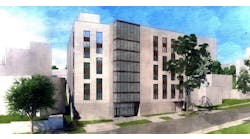As common sense as this may sound, remember to allow for technology moves, adds and changes in a building infrastructure. Make sure this is included in the planning process.
For example, a school district in a southern state installed a cable tray more than 25 feet in the air above the finished floor in the hallways. When the contractor was asked how anyone was going to reach the cable tray once the building was completed, he replied: “They won't be able to.” Asked “How will the school do technology additions in the future?” he said: “Why would anyone need to do that?”
It is amazing to find architects, engineers and designers that do not understand the concept of a building whose functions evolve after it is constructed. There always seems to be a debate for oversized conduits and cable trays. These two items are among the first things on the list to be eliminated from a building project when construction budgets need to be reduced. When one sees cables pulled across ceiling grids, often exposed in hallways and down walls in exposed raceways, you can bet it was an attempt to save money.
Think back to any facility in your district or on your campus: are all the spaces being used in the same manner as they were on the day it opened? Somewhere in those ceilings are wires that have been moved or added. Lifting up a ceiling tile in an existing building usually reveals whether a building has the right infrastructure that allows for moves, adds and changes. Contractors often take the easiest path permitted, so technology designers should make that path to the data closet the one that will best serve the institution. In any building there will be changes that are all proper functions of an evolving education facility. But installing the right infrastructure when the building is constructed will bring about this growth in a structured manner.
Many retrofit projects become very expensive when a wire-management system and conduits need to be added. It is far cheaper to build the proper foundation in the beginning of a building project than to add it later.
Schools always should require additional rack space in the data closets for growth — about 20 percent of what originally is being installed, as well as additional sleeves between firewalls and oversized conduits (usually 1 inch) to each data outlet — all with the thought of adding additional technology cabling in the future. These relativity inexpensive steps will ensure a building's technology growth will be less costly.
Some education institutions don't give much thought to the future of their technology infrastructure. However, as software and hardware change, the infrastructure also must change. Finding the dollars associated with these changes later on can be hard.
C. William Day is senior analyst at KBD Planning Group, Young Harris, Ga., a firm specialized in education facilities and technology planning. He can be reached at [email protected].

